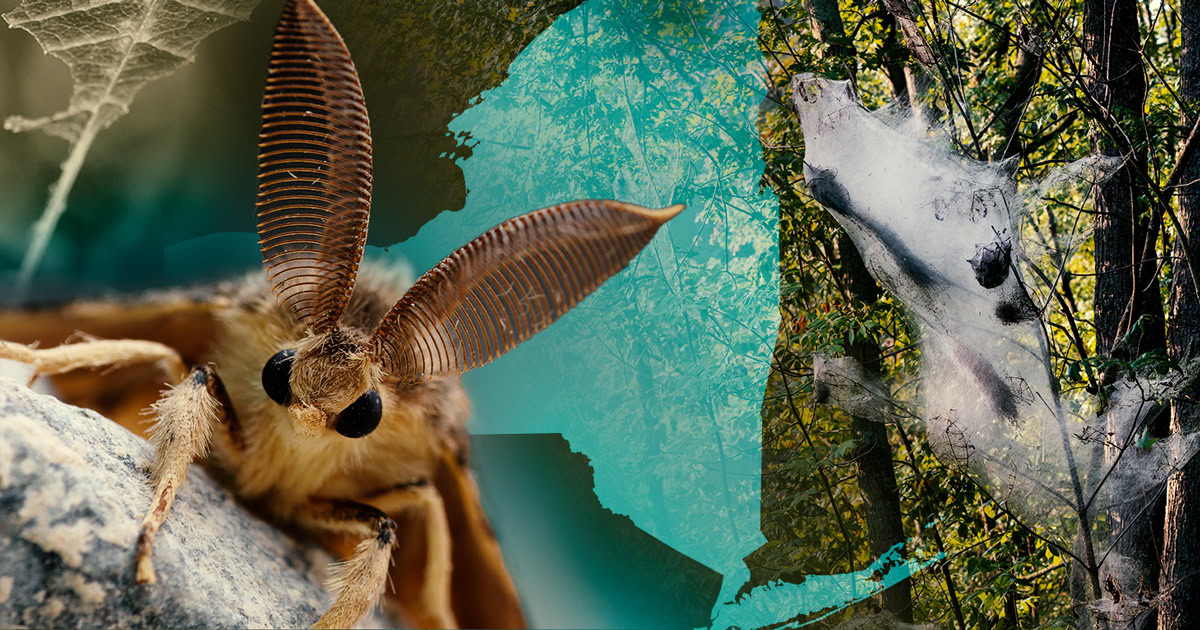In the Hudson Valley this year, it’s felt like it’s impossible to get away from gypsy moths (also known as spongy moths). Seemingly overnight, they’ve popped up everywhere: in backyards, on street trees, and on everyone’s favorite hiking trails.
We knew things were getting bad when, during a recent hike at Minnewaska State Park, we heard the sound of a rainstorm beginning. It was a completely sunny day, so we were very confused; until we realized that the cacophony was actually the gypsy moth droppings hitting leaves and the ground.
Gypsy moths are a phenomenon that comes around in cycles. While they’re always present, they can compound on themselves in successive years if they have favorable weather conditions and their natural predators aren’t in full force. They can also get wiped out due to disease.
As a creative marketing agency, we often use tools like Google Trends to quantify trends and measure the spread of ideas for search engine optimization. Today, we’re going to use Google Trends to try to chart the spread of gypsy moth in New York State for the last few years.
Let’s start with 2021.
New York Gypsy Moth in 2021
In 2021, the gypsy moth was most prevalent and explosive in the Elmira and Rochester, NY area according to Google Trends. A Democrat and Chronicle article at the time summed it up: Gypsy moth caterpillars are ravaging upstate NY trees, raining down feces: ‘It’s biblical’.
The Plattsburgh, NY area was the second-most intense area, according to Google. An article at the time reported that the crisis was at the level of state politicians raising awareness and encouraging people to destroy the insects’ egg pods if seen.
New York Gypsy Moth in 2022
Starting in 2022, we have more granular data. Elmira, the seat of Chemung County, had the highest concentration of Google searches related to gypsy moths.
Next there was the Lake George Region, including Warren and Essex counties. Luckily for them, a nasty virus wiped them out before they could continue their reign of terror.
In third were towns like Milton in Saratoga County and the Capital Region. The Albany Times-Union wrote that “The ravenous larva of the spongy moth – once known as the gypsy moth – can denude and kill a variety of broad-leaf trees no matter what you call them.”
New York Gypsy Moth in 2023
Ticonderoga was the most concentrated city for gypsy moths in 2023, after ranking near the top in 2022.
In 2023, gypsy moths arrived in great numbers in the Hudson Valley, where we’re located. Copake and Columbia County had the highest concentration of Google searches, followed by Middletown and Orange County, Milton and Ulster County, Stanfordville and Dutchess County. Elmira, in Chemung County, was the only exception outside of the Hudson Valley.
New York Gypsy Moth in 2024
When viewing gypsy moth search intensity by city, all 26 entries on the list are located in the Hudson Valley region. We truly are experiencing the brunt of them this year, and since it’s for a second straight year, repeated defoliation could be taking a major toll on local trees.
The top cities experiencing gypsy moths, with the highest percentage of searches related to the topic include Annandale-On-Hudson, Port Jervis, Ellenville, West Shokan, Lagrangeville, Copake Lake, Walden, Stanfordville, Montgomery, Stone Ridge, Livingston, Gardiner, Kerhonkson, Hyde Park, Pine Bush and more.
Has Gypsy Moth Peaked in 2024?
Surprisingly, no. Based on historical data, the phenomenon of gypsy moths in the region, and the resulting searches for information about them, will probably peak a couple of weeks into June.
After that, the gypsy moths will mate and go into hiding, out of sight, out of mind. Where will they go in 2025?
Kingston Creative is a full-service marketing agency in Kingston, NY, offering websites, marketing services and branding for local small businesses and organizations.

